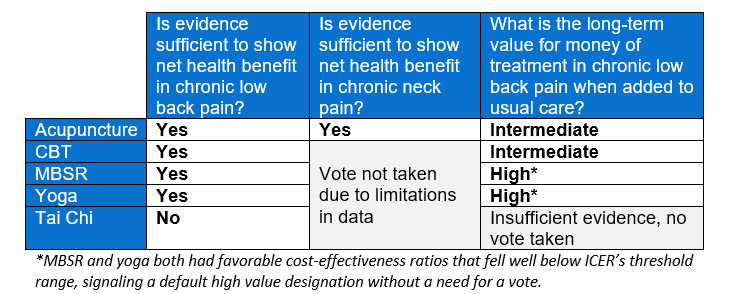|
–Evidence suggests safe and effective treatments include acupuncture, cognitive behavioral therapy, mindfulness-based stress reduction, and yoga–
|
| Boston, Mass., November 6, 2017 – The Institute for Clinical and Economic Review (ICER) today issued a Final Evidence Report assessing the comparative clinical effectiveness of acupuncture, cognitive behavioral therapy (CBT), mindfulness-based stress reduction (MBSR), tai chi, and yoga for treatment of chronic low back and neck pain, as well as the value of these therapies in chronic low back pain. The report includes a summary of a public meeting of the California Technology Assessment Forum (CTAF), during which the independent CTAF panel deliberated and voted on evidence presented in ICER’s report.
“Findings from our report and the votes of the CTAF panel suggest that there is adequate evidence to support broader insurance coverage of all of these therapies except for tai chi, where the evidence is still inconclusive. Good studies have shown that these other modalities can reduce pain and improve function for people with chronic low back pain, and they pose fewer risks than opioids or surgery,” noted David Rind, MD, MSc, Chief Medical Officer of ICER. “Unfortunately, even in the face of an opioid epidemic, many patients are not offered these alternative types of pain management. Stakeholders, particularly payers, should work to ensure that patients are able to access a broad range of evidence-based non-drug interventions with at least as much ease as they are able to access pharmacologic treatments.” During the public meeting, the CTAF panel voted on key questions related to the evidence presented in ICER’s report. The below results reflect a majority of the panel members’ votes. |

ICER’s final report includes key policy recommendations aimed at advancing currently available evidence and supporting collaboration among stakeholders to ensure access for patients. Key recommendations include:
- The strength of evidence appears adequate to support coverage of acupuncture, CBT, MBSR, and yoga for chronic low back pain as part of the regular medical benefit. Coverage policies should be clear and efficient so that providers can order these therapies as easily as they order physical therapy or a pain medication.
- Reimbursement for cognitive and mind-body therapies needs to be adequate to support a robust network of providers.
- Specialty societies should develop clear guidelines for the use these therapies for chronic pain and develop appropriate licensing and credentialing criteria for practitioners.
- Researchers should promote long-term studies for these interventions and study whether these therapies are effective in reducing or eliminating use of opioid therapy for patients with chronic pain.
A more detailed explanation of key policy recommendations is included in ICER’s full report. A summary of the key findings of the report is available in ICER’s Report-at-a-Glance.
About ICER
The Institute for Clinical and Economic Review (ICER) is an independent non-profit research institute that produces reports analyzing the evidence on the effectiveness and value of drugs and other medical services. ICER’s reports include evidence-based calculations of prices for new drugs that accurately reflect the degree of improvement expected in long-term patient outcomes, while also highlighting price levels that might contribute to unaffordable short-term cost growth for the overall health care system.
ICER’s reports incorporate extensive input from all stakeholders and are the subject of public hearings through three core programs: the California Technology Assessment Forum (CTAF), the Midwest Comparative Effectiveness Public Advisory Council (Midwest CEPAC), and the New England Comparative Effectiveness Public Advisory Council (New England CEPAC). These independent panels review ICER’s reports at public meetings to deliberate on the evidence and develop recommendations for how patients, clinicians, insurers, and policymakers can improve the quality and value of health care. For more information about ICER, please visit www.icer-review.org.
